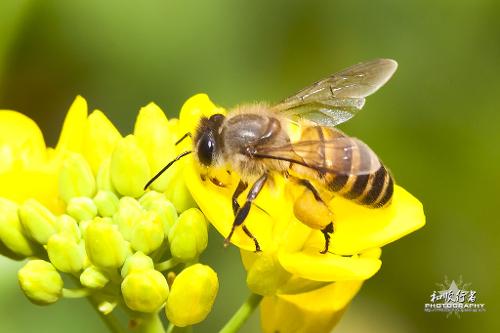
 |
|

2017年6月7日,国际知名学术期刊《PLOS ONE》杂志在线发表了美国韦伯斯特大学Nicole E. Miller-Struttmann研究员的一篇研究论文,论文报道了研究蜜蜂的嗡嗡声可能是了解蜜蜂授粉行动。
就像喷气式飞机会在无线电台呼告空中交通管制一样,蜜蜂的嗡嗡声也能帮助科学家谁在大片土地上为何种植物授粉,以便改进耕作方式和提高作物产量。
在过去,农民主要依靠视觉观察了解授粉者的活动,这是一个费时费力的过程。因此,研究人员编录了不同蜜蜂的身体特征,例如舌头长度、翅膀尺寸和身体大小,这些都会影响其授粉的植物类型,以及发出的嗡嗡声的声频。然后,研究人员制作了两种熊蜂的声波标记图。这两种蜜蜂栖息在美国科罗拉多州博尔德附近,分别是Bombus balteatus (如图)和B. sylvicola。
研究人员在两个花季使用野外记录设备,倾听了活动在不同野花丛中的蜜蜂的声频。这些声音记录帮助科学家估算了一个给定区域的蜜蜂数量。
而且,通过系统地排除蜜蜂的某些特征,例如更短的舌头,以及追踪该区域中的那些植物接受了授粉,研究人员能将某些声频将不同植物联系在一起,例如三叶草。
这就意味着,研究人员理论上能计算出在每个授粉季,何种蜜蜂在哪里,以及它们在做什么。
这样一来,通过监控田地里的背景声音,种植者将能知道他们是否有何时的蜜蜂前来工作,或是否需要打电话求援。
原文摘要:Multiple interacting factors drive recent declines in wild and managed bees, threatening their pollination services. Widespread and intensive monitoring could lead to more effective management of wild and managed bees. However, tracking their dynamic populations is costly. We tested the effectiveness of an inexpensive, noninvasive and passive acoustic survey technique for monitoring bumble bee behavior and pollination services. First, we assessed the relationship between the first harmonic of the flight buzz (characteristic frequency) and pollinator functional traits that influence pollination success using flight cage experiments and a literature search. We analyzed passive acoustic survey data from three locations on Pennsylvania Mountain, Colorado to estimate bumble bee activity. We developed an algorithm based on Computational Auditory Scene Analysis that identified and quantified the number of buzzes recorded in each location. We then compared visual and acoustic estimates of bumble bee activity. Using pollinator exclusion experiments, we tested the power of buzz density to predict pollination services at the landscape scale for two bumble bee pollinated alpine forbs (Trifolium dasyphyllum and T. parryi). We found that the characteristic frequency was correlated with traits known to affect pollination efficacy, explaining 30–52% of variation in body size and tongue length. Buzz density was highly correlated with visual estimates of bumble bee density (r = 0.97), indicating that acoustic signals are predictive of bumble bee activity. Buzz density predicted seed set in two alpine forbs when bumble bees were permitted access to the flowers, but not when they were excluded from visiting. Our results indicate that acoustic signatures of flight can be deciphered to monitor bee activity and pollination services to bumble bee pollinated plants. We propose that applications of this technique could assist scientists and farmers in rapidly detecting and responding to bee population declines.
|
|